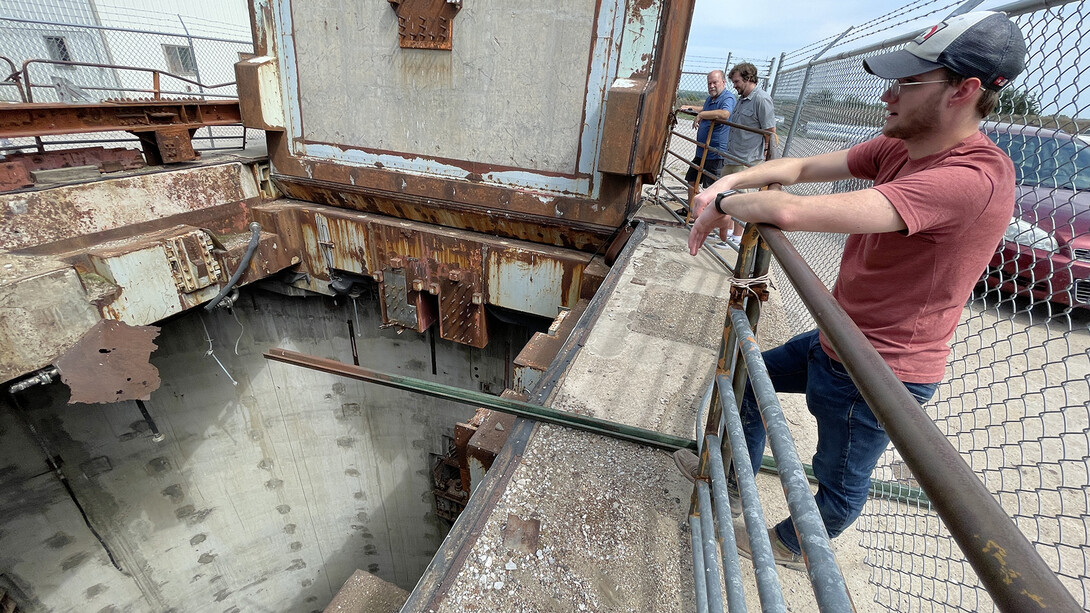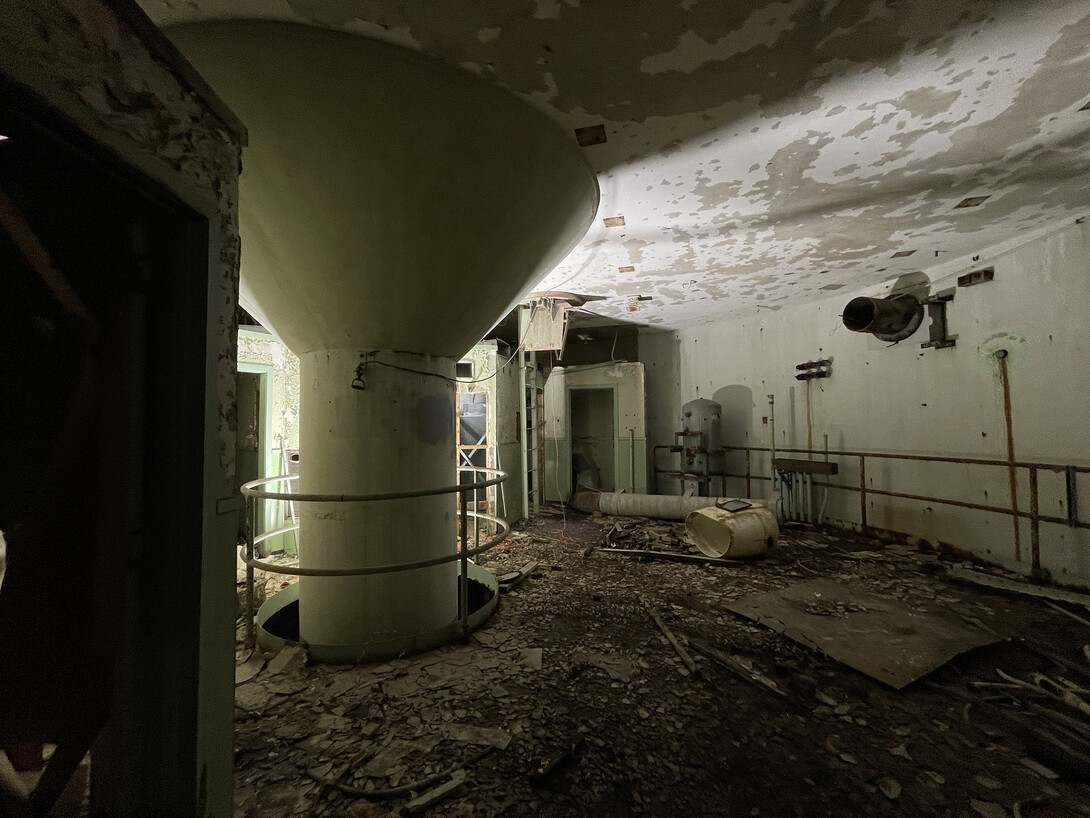
University of Nebraska–Lincoln students and researchers are working to bring new life to a Cold War relic in Nebraska.
With a planning grant from the Grand Challenges research initiative, an interdisciplinary team is planning and designing a testing facility for ice core drilling equipment in an abandoned Atlas-F missile silo near Seward. The proposed facility would also include educational outreach and exhibition space.
Upon completion, the Ice Coring and Education Silo Center will be the first facility of its kind in the world.
The impetus for the project was the need for full testing of ice core drilling equipment before it is shipped to remote field stations in Greenland and Antarctica. David Harwood, principal investigator on the grant and professor in Earth and Atmospheric Sciences, is leading an international team of scientists in an ice drilling project examining the impacts of climate change. Harwood, lead driller Dennis Duling, and Jim McManis, manager of the engineering shop in the College of Engineering, were exploring options for testing the drilling equipment prior to travel as transporting the equipment costs about half a million dollars each trip and equipment failure in the field impacts scientific outcomes. Testing equipment locally could potentially decrease risks significantly.
It was Duling who thought of the old underground missile silo — one of 12 built in Nebraska in the 1960s. Through Grand Challenges meet and greets, Harwood and colleague Mindi Searls, research assistant professor in the Department of Earth and Atmospheric Sciences, were introduced to Brian Kelly, associate professor of architecture. Kelly has been researching the silos for the past four years and taught several studios centered around repurposing the abandoned structures.
“It was serendipitous that our areas of research overlapped,” Kelly said. “I was excited to help explore the possibilities of how they could repurpose the silo for testing, and what better learning opportunity for my students than to bring them into a collaborative, interdisciplinary design project with faculty from across the campus.”
Students in the College of Architecture’s Collaborate studio explored concepts for the center as part of their fall semester project. These concepts will be used in future project development, planning and grant application efforts.
So far, the team and the students have identified three focus areas for the spaces in the proposed 70,000-square-foot facility — ice drilling equipment fabrication and testing, exhibition and educational outreach.
Ice core drilling
The ice core drilling equipment testing center with an adjacent workshop has the potential to save the university time and money by trouble-shooting the equipment before the drilling team travels to remote locations.
“We don’t usually have an opportunity to test the equipment before shipping new tools into the field,” Harwood said. “There is so much effort in setting up remote field camps on top of ice sheets, often they are three years in development, traversing and shipping, so it is critically important that the tools doing the science are the best they can be, and that they work as needed to do the science.”
By having a local testing center and workshop, it would also increase their onsite efficiencies and drilling approaches.
“The workshop would allow engineers and drillers to make adjustments and modifications to their drills and instruments after testing,” Harwood said. “It would enhance UNL’s ability to design, develop and test its own drills and instruments, building upon our past success in this field.”
Although the abandoned silo site is much shorter than the drilling depth used by scientists and researchers in Antarctica and Greenland, the proposed 150-feet-deep and 10 feet in diameter ice column is all they need for testing, simulation and calibration.
“The entry into the ice and the point where they break through into the subglacial lake are the points that are crucial for the drill team to understand how the equipment will perform, and our proposed testing site will simulate those situations for them,” Kelly said.
Ideally, the testing center will also be a research destination for other universities who also need to test their drilling systems and run their drills. There are numerous national and international polar scientists and engineers from ice-drilling research institutions who are potential users for this center.
“I can see this facility filling an international research niche,” Harwood said. “There are always challenges working in remote polar regions, far from logistical support centers and resupply shops, but this new facility would help reduce those risks and ensure that ice drilling systems from UNL, or other national and international research centers, would be mission ready. This facility would be able to ‘custom-build’ columns of ice specific to what each project would expect in the field.”

Exhibition and outreach focus
Another focus of the center will be an exhibition area to showcase local history, the science of ice core drilling, issues around climate change, and Earth and atmospheric sciences.
A prime exhibition example would be the history of area missile silos. A brief period of time, it’s a story unknown to many, but the Lincoln Air Force Base played a significant role in the United States’ Cold War history, controlling the launch sites for 12 missile silos near Eagle, Elmwood, Avoca, Nebraska City, Palmyra, Tecumseh, Beatrice, Cortland, Wilber, Seward, York and Brainard. Construction for these silos started in 1959, was completed in about one year, and by 1965, all silo sites were decommissioned.
Bringing elementary and high school teachers and students to facilities like this to learn about the silo’s Cold War history, the science of ice-core drilling, or the engineering challenges it took to build the silos and to repurpose them, would be a significant resource for Nebraska educators.
“The educational possibilities here are really endless,” Kelly said. “This project has amazing potential for adjacent communities.”

Forging ahead
Although many design projects for College of Architecture students are hypothetical, Kelly said the ICE Silo is a facility they hope to build with various partners.
This is a multi-phased, multi-year project at Nebraska U, which could be used by by future studios for student learning with additional development with NU researchers, Kelly said.
“This is an exciting opportunity for my students because they are exposed to research and development for a project type that doesn’t currently exist,” he said. “There are no other facilities like this in the world, so this is energizing for us to be on the ground floor of a project like this.”
Harwood, McManis and Searls served as consultants for the students as they created and developed their concepts offering advice and guidance during meetings and project critiques.
“It was great to see the projects develop, and we were very impressed with the creativity and dedicated effort of the students in Brian Kelly’s Design Studio,” Harwood said. “They rose to and met the challenges presented to them. It is clear that they had fun, and the quality of the four treatments indicated they learned a lot.”
Kelly’s Collaborate studio, for fourth-year students, is structured to be interdisciplinary with interior design, landscape architecture and architecture students, giving them an experience similar to that of a design firm. The ICE Silo fits the studio’s learning outcomes well, offering students exposure to multiple design aspects of the built environment.
“It’s great working in the collaborative environment of our studio,” Daniel Pinto, one of Kelly’s students, said. “We have students from various college disciplines, and it is exciting because I get to hear from different perspectives. This project is probably the most fleshed out project I’ve worked on so far, and I think that speaks to all the disciplines working together.”







